As an Amazon Associate KitchenwareSets.com earns from qualifying purchases.
11 Genius Ideas To Hide A Washing Machine In Your Kitchen
Struggling with that bulky washing machine ruining your kitchen’s style? It’s a common headache in apartment living. That appliance, a symbol of utility, often feels like an eyesore, disrupting the design harmony you want for your space.
You’re trying to create a beautiful, functional kitchen, but the laundry setup feels awkward and out of place. This guide is here to change that. We’ll show you how to seamlessly integrate your laundry into your kitchen design.
The most effective ways to hide a washing machine in a kitchen include integrating it into custom cabinetry, concealing it behind bifold or sliding doors, or using a simple fabric curtain for a budget-friendly solution. These clever methods help you maintain a cohesive and uncluttered kitchen aesthetic. Let’s explore 11 genius ideas to solve your laundry dilemma for good.
Why Does a Washing Machine in the Kitchen Feel So Awkward?
That feeling of frustration is completely valid. A washing machine is a bulky, often noisy appliance that feels fundamentally out of place next to your oven and refrigerator. In a small kitchen, where every inch is precious, it can feel like a major design disruption, turning a potentially seamless space into a cramped, utilitarian zone. The core challenge is integrating this piece of utility with your kitchen’s style.
The good news is you don’t have to live with this design conflict. Countless apartment dwellers have faced this exact problem and found clever, elegant solutions. This guide promises 11 genius ideas, curated from established interior design principles, that transform that appliance eyesore into a seamless, integrated feature. We’ll cover everything from high-end custom builds to renter-friendly hacks that are both visually inspiring and completely actionable.
11 Genius Ideas To Hide A Washing Machine In Your Kitchen
Finding the perfect way to conceal your kitchen laundry is easier than you think. We’ve gathered a range of solutions to fit every budget, style, and skill level. Whether you’re planning a full renovation or just need a quick, clever fix for your apartment, there’s an idea here for you. Each solution addresses common real-world challenges like noise and ventilation, ensuring your hidden laundry is as practical as it is beautiful.
1. Achieve a Seamless Look with Custom Panel-Ready Cabinetry
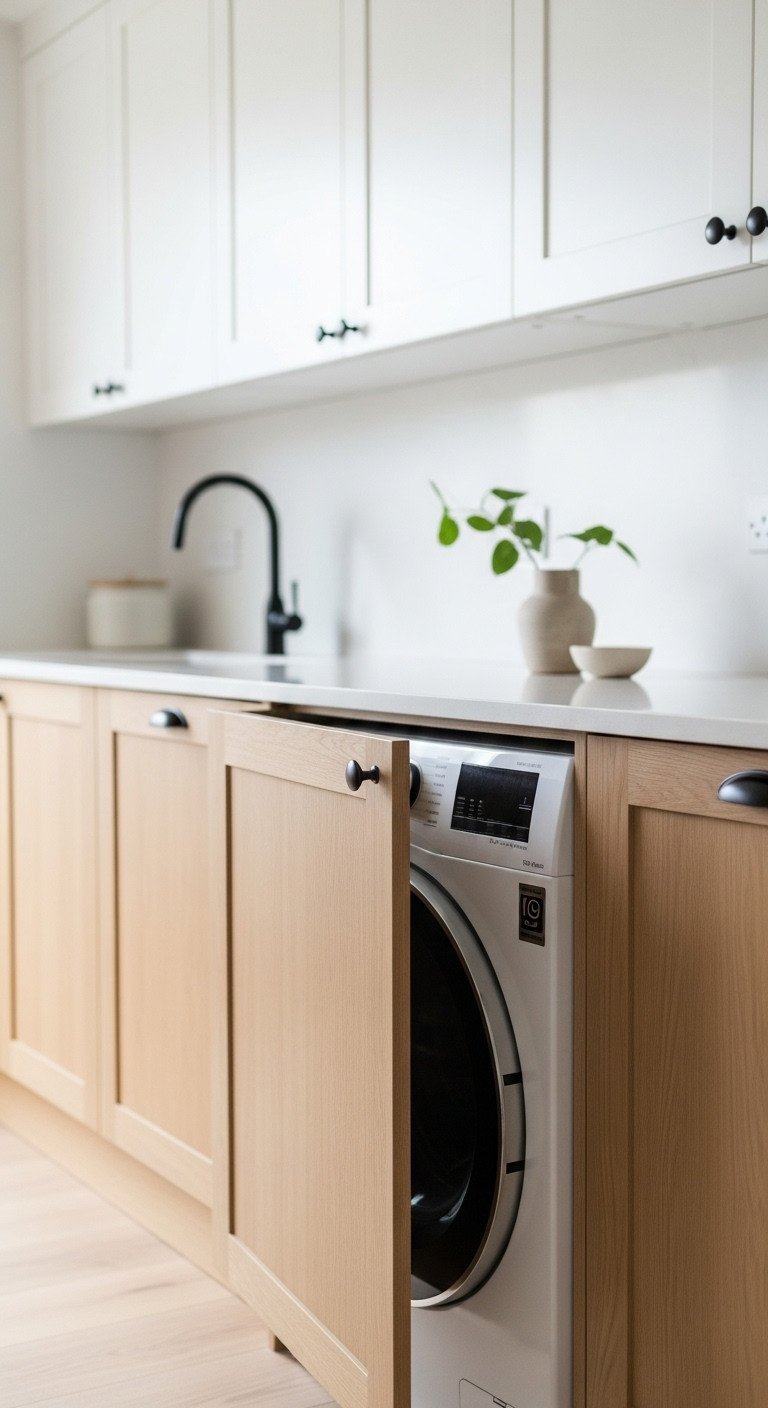
Pin this seamless laundry solution to your ‘Dream Kitchen’ board!
For a truly high-end, minimalist kitchen, nothing beats the invisible integration of a panel-ready washing machine. This is the ultimate concealment method, where the appliance is fitted with a custom cabinet front that matches your existing kitchen cabinetry perfectly, making it completely disappear.
Materials Needed:
- Panel-ready compact washing machine or washer-dryer combo
- Custom cabinet door panel matching your existing kitchen cabinets
- Heavy-duty cabinet hinges rated for appliance door weight
- Cabinet hardware (handle or push-to-open latch)
- Reinforced cabinet carcass, built 3-4 inches deeper than standard
- Waterproof drip pan with a drain connection
Step-by-Step Directions:
- Select Appliance: Choose a panel-ready washing machine. According to manufacturer best practice, you must obtain its detailed spec sheet for exact dimensions before building any cabinetry.
- Build the Enclosure: Construct or order a cabinet box that is deeper than your standard cabinets to allow for hoses and ventilation. Reinforce the base to handle vibrations.
- Install Utilities: Have a licensed plumber and electrician run water, drain, and a dedicated electrical circuit to the cabinet. This is a universal safety standard. Install the drip pan as an essential safety feature.
- Mount the Panel: Carefully follow the appliance manufacturer’s instructions to attach your custom cabinet panel to the front of the machine.
- Install Machine: Slide the appliance into the enclosure, connect the utilities, and level it perfectly using a spirit level.
Pro-Tip: For a truly seamless look, use a push-to-open latch mechanism instead of a handle on the cabinet door. This makes the appliance completely indistinguishable from any other cabinet.
2. Save Space with Classic Bifold Doors
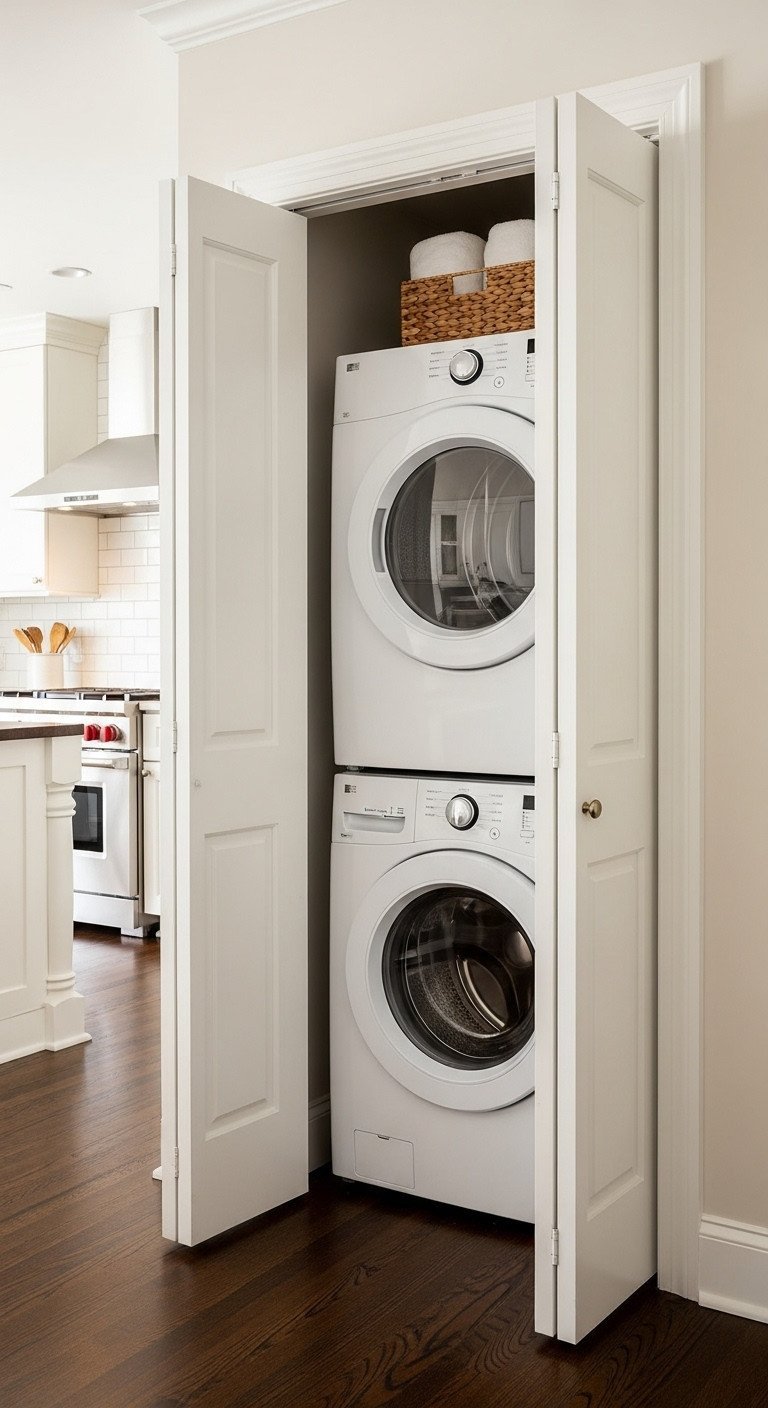
Save this clever bifold door idea for small kitchens!
If your kitchen is narrow or the appliance is in a corner, a traditional swinging cabinet door can block a walkway. Bifold doors are the perfect space-saving solution, folding in on themselves so they take up minimal room when open, providing full access to your stackable washer and dryer.
Materials Needed:
- Bifold door kit (including doors, track, and hardware)
- Stackable compact washer and dryer units
- Lumber for framing the closet opening
- Drywall and paint to match your kitchen
- Heavy-duty anti-vibration pads for under the washer
Step-by-Step Directions:
- Frame the Opening: Build a frame for a closet nook that is wide and deep enough to house your stackable units plus 3-4 inches of clearance at the back and 1 inch on the sides.
- Install Utilities: Have professionals run the necessary plumbing, electrical (including a 240V outlet for the dryer), and dryer vent ducting.
- Finish the Closet: Install drywall, tape, and paint the interior and exterior of the new closet to match your kitchen.
- Install the Track: Mount the bifold door track to the top of the finished opening according to the manufacturer’s instructions.
- Hang the Doors: Attach the pivot and guide hardware to the doors and hang them in the track. Adjust them so they open, close, and fold smoothly.
Lesson Learned: Choose a high-quality, heavy-duty bifold door track system. Cheaper kits use plastic components that can break or operate poorly under the frequent use of a laundry closet.
3. Use a Stylish Fabric Curtain for a Budget-Friendly Fix
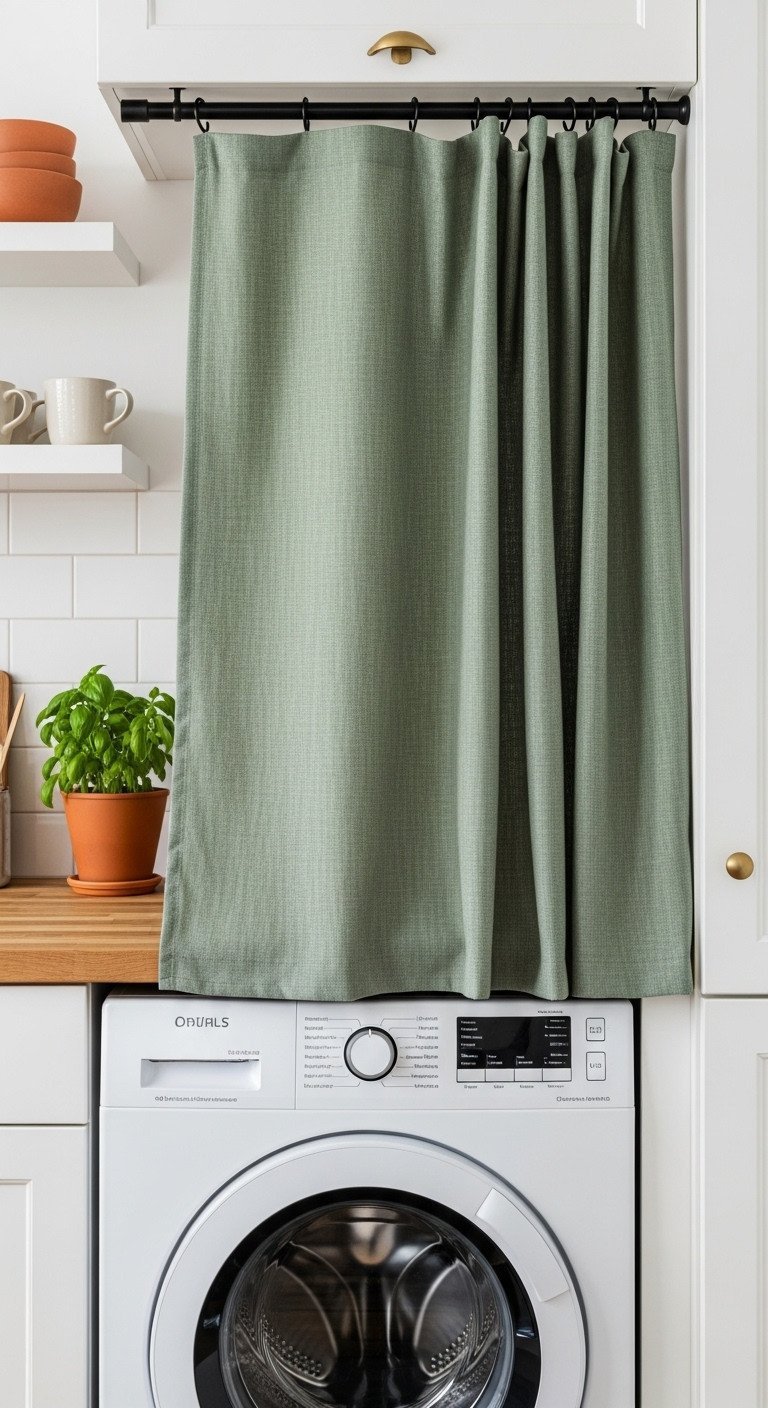
Pin this easy, renter-friendly kitchen hack!
For renters or anyone on a budget, a fabric curtain is the perfect DIY fix. This landlord-friendly solution requires no drilling and allows you to add a pop of color or texture to your kitchen while elegantly hiding the appliance. It’s a simple, affordable, and stylish way to solve the problem.
Materials Needed:
- A high-quality tension rod strong enough to hold the curtain’s weight
- Fabric curtain panel(s) in a style and color that complements your kitchen decor
- Fabric tape or sewing kit (if hemming is needed)
- Tape measure
Step-by-Step Directions:
- Measure the Space: Measure the width of the opening where the washing machine sits. Purchase a tension rod that adjusts to fit this width.
- Measure for Height: Measure from the underside of your countertop to the floor. This is the ideal length for your curtain.
- Choose Your Curtain: Select a curtain panel. A medium-weight fabric like linen, cotton canvas, or twill hangs best.
- Hem if Necessary: If you can’t find the perfect length, use iron-on fabric tape for a no-sew way to hem the curtain to the correct height.
- Install: Extend the tension rod inside the opening, just under the countertop, making sure it’s tight and secure. Slide the curtain on and arrange the fabric neatly.
Pro-Tip: Choose a curtain fabric that is machine washable itself. Kitchens can be messy, and you’ll want an easy way to clean any splashes or spills from your new curtain.
4. Integrate Laundry into a Multi-Functional Kitchen Island
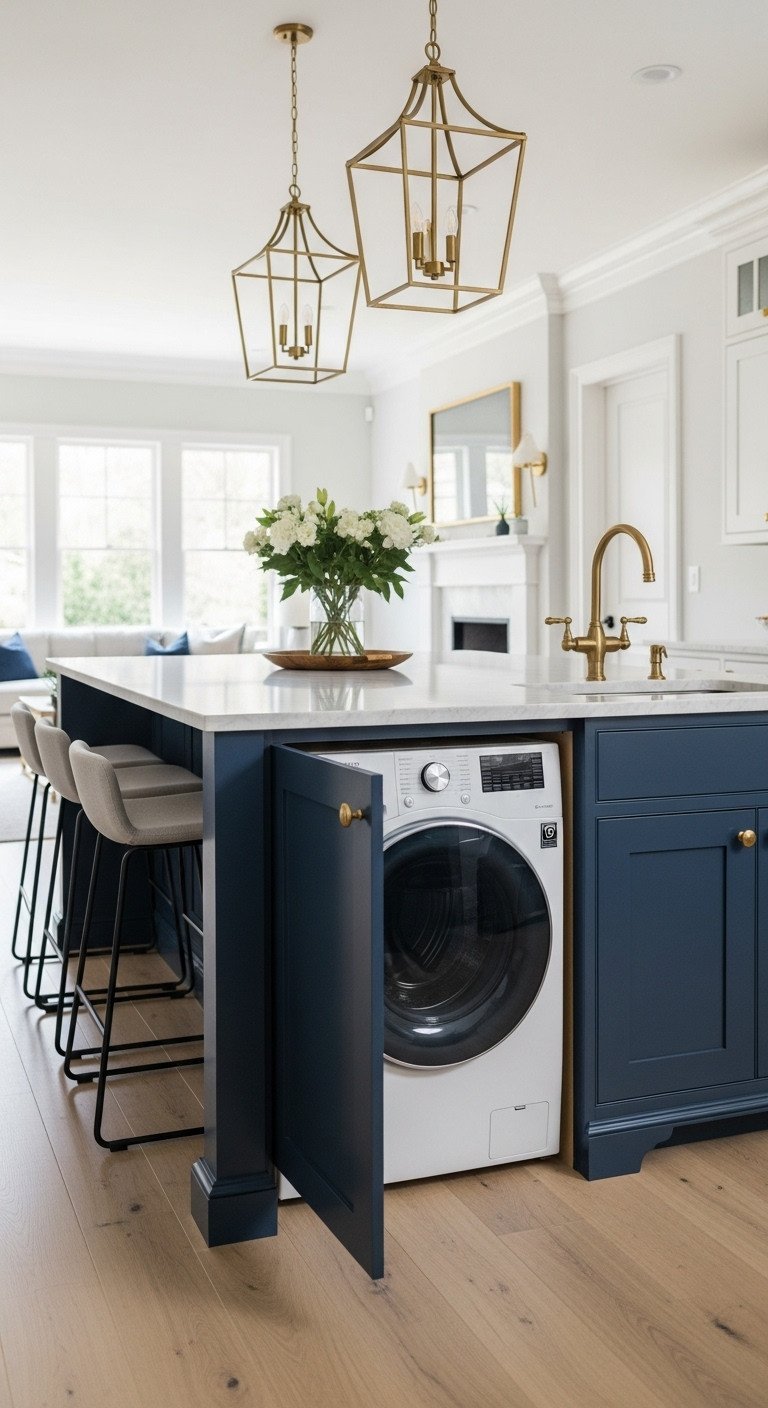
Save this brilliant kitchen island laundry idea for your renovation board!
In an open-plan living space, the kitchen island is the heart of the home. Why not make it work even harder? Integrating a quiet, low-vibration washer-dryer combo into your island is a brilliant, multi-functional solution that keeps your laundry completely out of sight.
What You’ll Need:
- A quiet, low-vibration washer-dryer combo unit specifically designed for living spaces
- Custom kitchen island cabinetry designed with a dedicated, reinforced appliance bay
- Professional plumbing and electrical work routed through the floor
- High-quality sound-dampening insulation for the appliance bay
- A waterproof drip pan plumbed to a drain
Step-by-Step Directions:
- Consult Professionals: This is not a DIY project. Work with a kitchen designer and contractor to design an island that can safely house the appliance.
- Plan Utilities: Your contractor will need to run water supply, a drain line, and a dedicated electrical circuit up through the subfloor into the island’s designated location before the island is installed.
- Build the Island: The island cabinet for the washer must be extra sturdy and have a reinforced base. Insulate the interior of the bay with sound-dampening material.
- Install Appliance: Once the island is in place, have a professional install the drip pan and the appliance, ensuring it’s perfectly level to minimize vibration.
- Add Doors: Fit the cabinet door to conceal the unit, ensuring it matches the rest of the island perfectly.
Pro-Tip: Vibration is the enemy in an island installation. Choose an appliance with the lowest decibel (dBA) and vibration ratings you can find, and insist on having it installed on heavy-duty anti-vibration mats inside the cabinet.
5. Tuck it Away in a Tall Pantry Cabinet

Pin this ultra-organized pantry laundry idea!
A tall pantry cabinet offers the perfect opportunity to create a “European laundry”—a compact, all-in-one station that disappears behind closed doors. By using a stackable washer and dryer, you leverage vertical space, leaving room above for organized shelving for all your laundry supplies.
Materials Needed:
- A tall cabinet (at least 28-30 inches wide and 32-34 inches deep)
- A compact stackable washer and dryer pair
- Stacking kit specifically for your appliance models
- Reinforced shelving for above the units
- Drip pan and professional utility installation
Step-by-Step Directions:
- Source the Cabinet: Use an existing pantry or purchase a new tall cabinet unit. Ensure its internal dimensions can accommodate your chosen appliances with proper clearance.
- Reinforce the Base: The bottom of the cabinet must be reinforced to support the weight and vibration of both machines.
- Install Utilities: Run plumbing, electrical, and venting into the back of the cabinet. A professional is required for this step.
- Install the Appliances: Place the drip pan, then the washer. Use the official stacking kit to securely mount the dryer on top of the washer.
- Add Storage: Install heavy-duty shelves in the space above the dryer for storing detergent, dryer sheets, and other laundry supplies.
Lesson Learned: Do not skip the official stacking kit from the manufacturer. It contains special brackets that lock the two machines together, preventing the dryer from vibrating off the washer during a spin cycle.
6. Go Modern with Sleek Sliding Doors
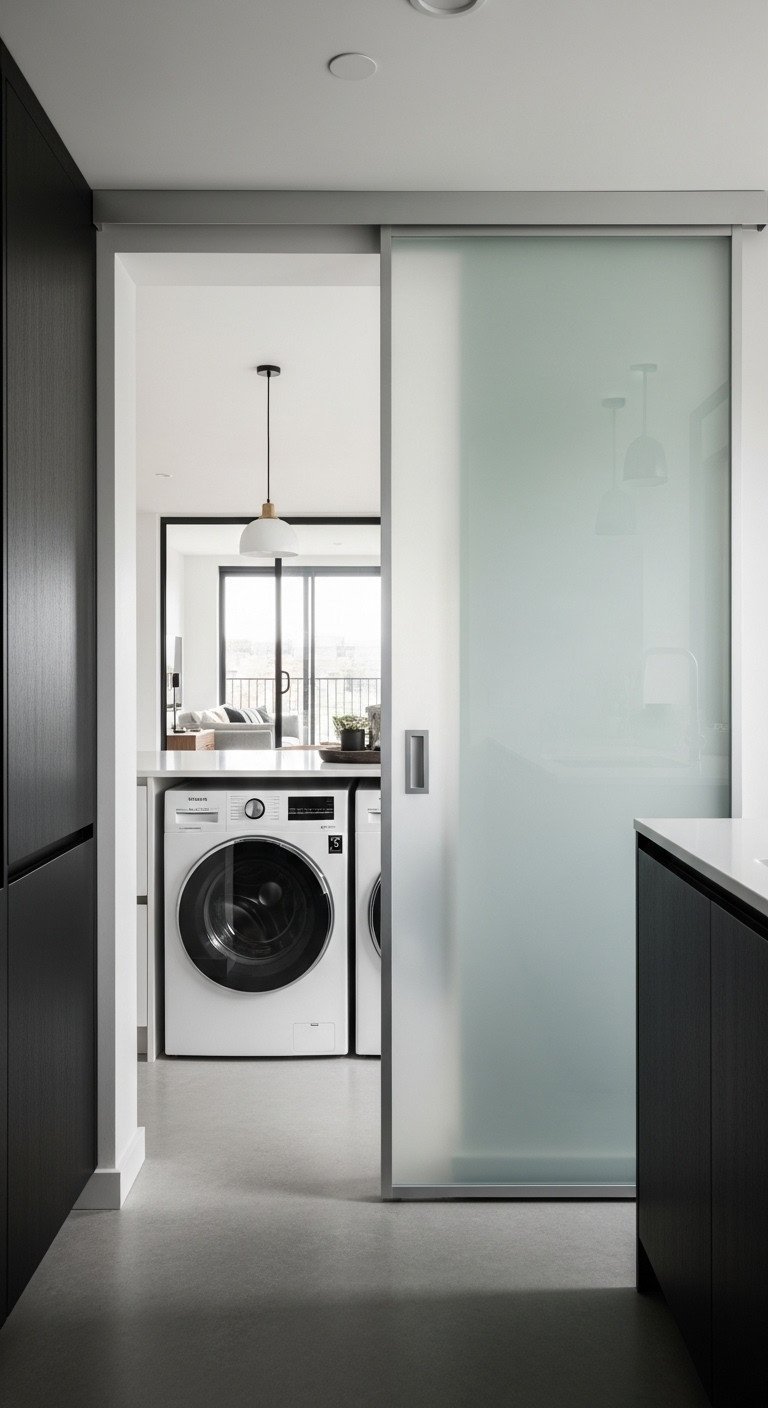
Save this sleek sliding door solution for a modern home!
For a contemporary look, sliding doors offer a stylish and space-efficient way to conceal a laundry nook. Unlike swinging doors, they don’t take up any floor space when open, making them ideal for high-traffic areas. You can choose a door that matches your walls for a hidden look or a statement door, like frosted glass or a rustic barn door, to add a design feature.
Materials Needed:
- Sliding door or barn door hardware kit
- Custom door panel(s) (e.g., frosted glass, solid wood, or MDF painted to match walls)
- Side-by-side front-loading washer and dryer
- A solid wall header to securely mount the track
Step-by-Step Directions:
- Frame the Nook: Create a recessed nook for your side-by-side washer and dryer. A countertop above the appliances is a great way to add a folding station.
- Reinforce the Header: The wall above the opening must have solid wood blocking installed to securely hold the weight of the sliding door track and doors.
- Install Utilities: Have your plumber and electrician set up the connections inside the nook.
- Mount the Track: Carefully measure and install the sliding door track on the reinforced header, ensuring it is perfectly level.
- Hang the Doors: Attach the rollers to your door panel(s) and hang them on the track. Install floor guides to keep the doors from swinging.
Pro-Tip: For a truly hidden look, design the sliding door to look like a decorative wall panel or paint it the exact same color as your wall with matching baseboards.
7. Create a Nook Beneath a Countertop Extension
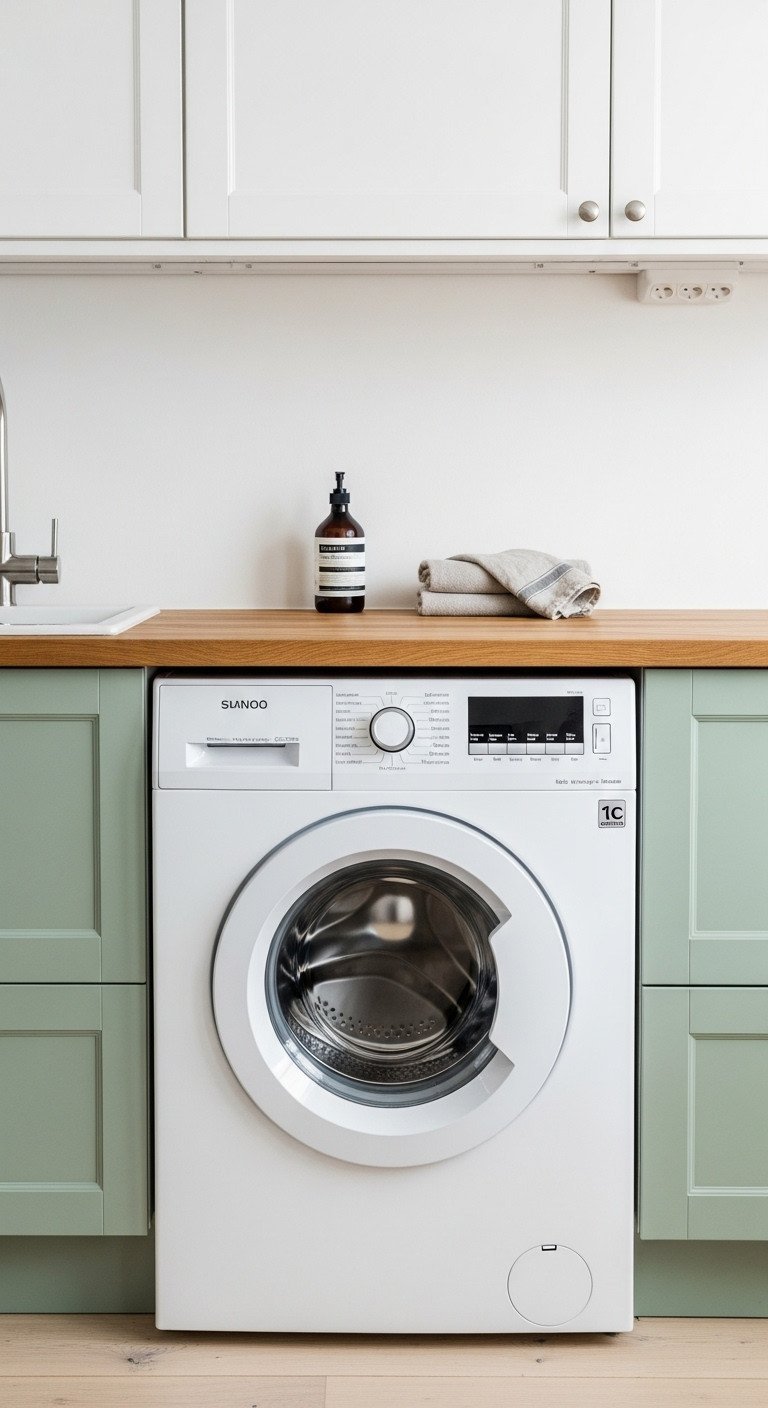
Pin this simple and functional countertop idea!
This simple yet brilliant idea involves extending your kitchen countertop beyond the last cabinet to create a dedicated nook for your washing machine. This not only gives the appliance a defined home but also provides you with valuable, continuous counter space above it for folding laundry or extra kitchen prep.
Materials Needed:
- A compact, front-load washing machine (check height to ensure it fits under a standard 36″ counter)
- A length of countertop material (e.g., butcher block, laminate)
- A supporting end panel or sturdy legs for the countertop
- “L” brackets to secure the countertop to the wall and end panel
Step-by-Step Directions:
- Position Appliance: Place your washing machine at the end of a run of base cabinets.
- Install End Support: Secure a support panel or sturdy furniture legs to the floor at the desired width of your new nook. This will support the open end of the countertop.
- Secure to Wall: If possible, install a wood cleat along the back wall at the correct height to provide additional support for the countertop.
- Install Countertop: Cut the countertop to length and place it over the washing machine, resting on the last base cabinet on one side and your new end support on the other.
- Fasten Securely: Use “L” brackets to fasten the countertop to the wall cleat and the end support panel from underneath.
Lesson Learned: Don’t let the countertop rest directly on the washing machine. Appliances need air circulation and vibrate during use. The countertop must be fully supported by the wall and an end panel/legs.
8. Repurpose an “Appliance Garage” for a Compact Unit
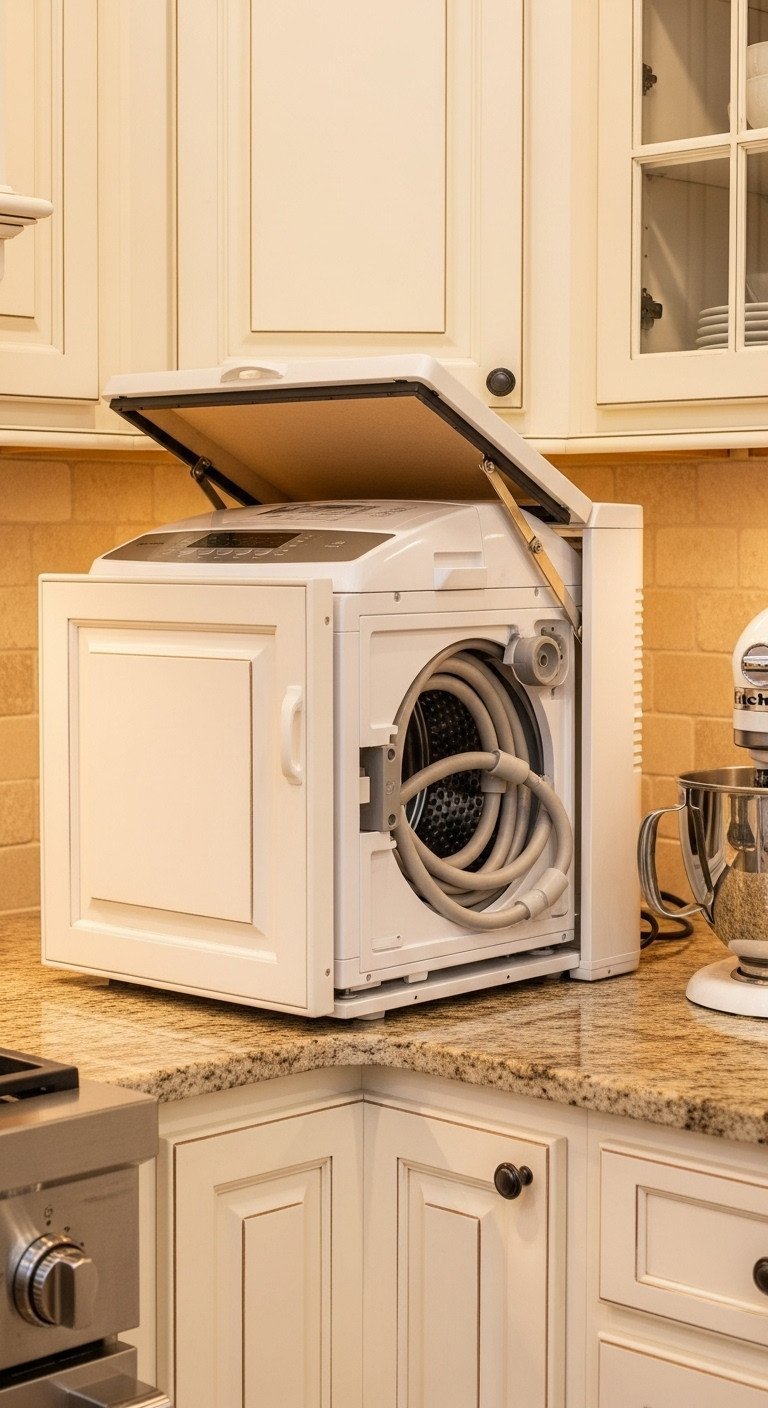
Save this unique idea for tiny apartment kitchens!
For those with tiny apartments and even smaller portable washing machines, the “appliance garage” concept is a perfect fit. Traditionally used for toasters and mixers, a larger appliance garage can sit on your countertop and completely hide a compact washer when it’s not in use.
Materials Needed:
- A super-compact or portable washing machine
- A pre-built or custom-built appliance garage with a tambour or lift-up door
- Quick-connect adapter for the kitchen faucet
- A small hole drilled in the back of the garage for the hose and power cord
Step-by-Step Directions:
- Find the Right Machine: This only works with the smallest portable washers. Measure your chosen machine carefully.
- Get the Garage: Purchase or build an appliance garage that is large enough to house the machine. Tambour (roll-up) doors are excellent for saving space.
- Modify for Access: Carefully drill a hole in the back of the appliance garage, large enough for the drain hose and power cord to pass through.
- Set Up for Use: When you need to do laundry, slide the machine out, connect the fill hose to your faucet using a quick-connect adapter, and place the drain hose in the sink.
- Store Away: When finished, disconnect the hoses, and slide the unit back into its garage, closing the door to hide it completely.
Pro-Tip: Place the appliance garage on a small rubber mat to protect your countertops from any drips when connecting or disconnecting the hoses.
9. Use Louvered Doors for Style and Ventilation

Pin this breezy and practical louvered door idea!
Louvered doors are both stylish and practical, making them an excellent choice for concealing a washer-dryer combo. Their slatted design adds a touch of coastal or traditional charm while, more importantly, providing essential air circulation for the appliance, which is critical for ventless dryer models.
Materials Needed:
- A ventless washer-dryer combo or condenser dryer
- A pair of louvered doors sized for your cabinet opening
- Cabinet hinges and hardware
- A reinforced, extra-deep cabinet box
Step-by-Step Directions:
- Choose a Ventless Appliance: This solution is specifically for ventless dryers, which need airflow to operate efficiently and prevent overheating.
- Build the Enclosure: Construct a cabinet that is deep enough for your appliance and has a reinforced base.
- Install the Appliance: Have a professional install the utilities and place the machine inside, ensuring it’s level.
- Mount the Doors: Install the louvered doors onto the cabinet face frame using high-quality hinges.
- Check Clearances: Ensure the doors can open fully without hitting the appliance and that there’s at least an inch of space between the back of the doors and the front of the machine.
Lesson Learned: Louvered doors provide airflow, but you still must follow the appliance manufacturer’s minimum clearance requirements inside the cabinet (usually a few inches on each side and in the back) for proper heat dissipation.
10. Maximize Efficiency with a Vertical Laundry Closet
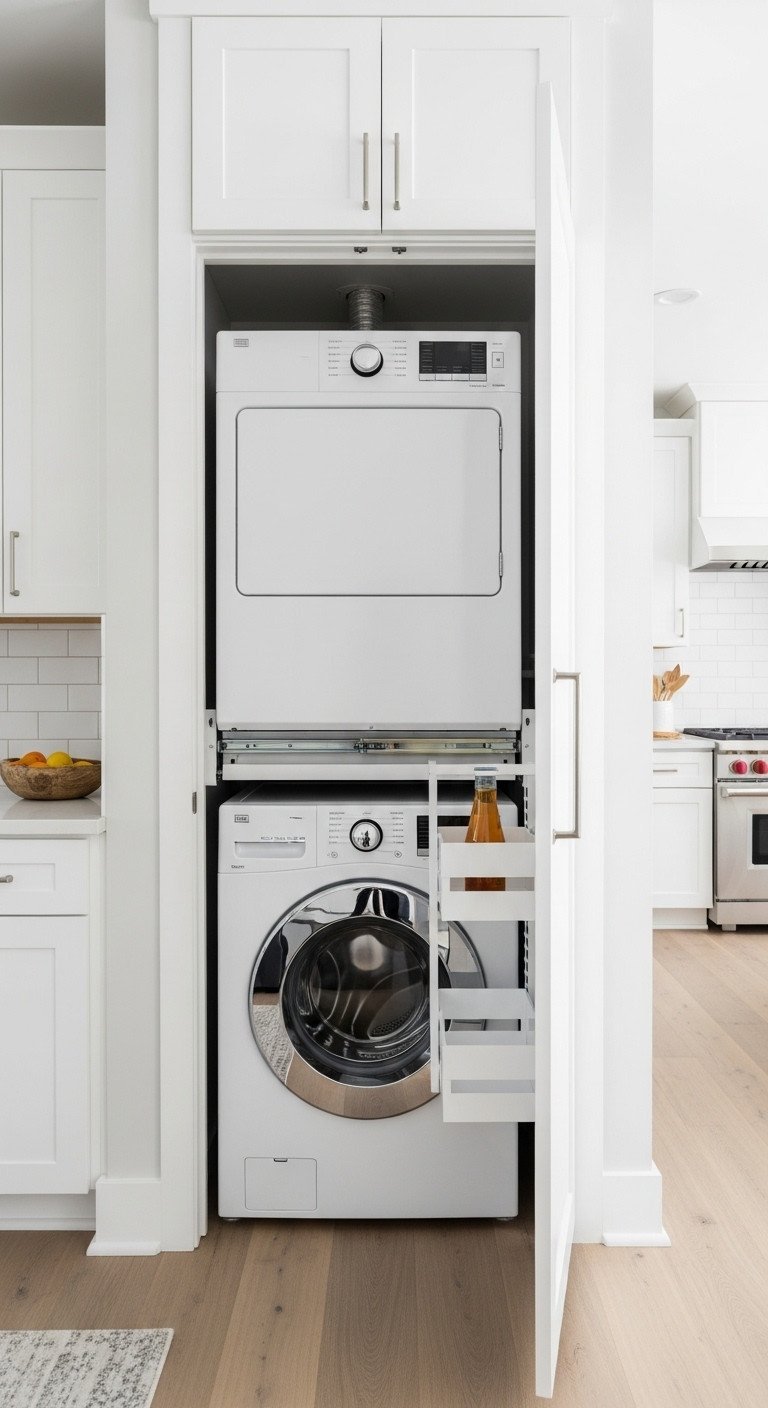
Save this ultimate space-saving laundry closet design!
This is the ultimate space-saving design for small apartments. By building a narrow, tall closet, you can house a separate stackable washer and dryer efficiently. The real genius is adding a pull-out shelf between the two machines, creating a hidden, on-demand folding station that doesn’t take up any extra room.
Materials Needed:
- Stackable washer and dryer and corresponding stacking kit
- Lumber and drywall to build the closet
- A single cabinet door that matches the kitchen
- Heavy-duty drawer slides and a piece of finished plywood for the pull-out shelf
- Anti-vibration pads
Step-by-Step Directions:
- Design the Closet: Frame a closet just wide and deep enough for your stacked units, plus required clearances. Plan for a middle support to hold the pull-out shelf.
- Install Shelf Supports: Install sturdy wooden supports on the sides of the closet frame at a height just above the washer.
- Run Utilities: Have professionals run all necessary plumbing, venting, and electrical into the closet space.
- Install Washer: Place the washer on anti-vibration pads inside the closet.
- Install Shelf & Dryer: Attach heavy-duty drawer slides to the supports and your shelf. Slide it in. Then, use the stacking kit to safely place the dryer on top of the washer.
- Hang the Door: Install a single, full-height door to conceal the entire closet.
Pro-Tip: The pull-out shelf is the game-changer here. It provides a much-needed surface for sorting or folding right where you need it, without taking up permanent space.
11. Make it Vanish with Disappearing Pocket Doors
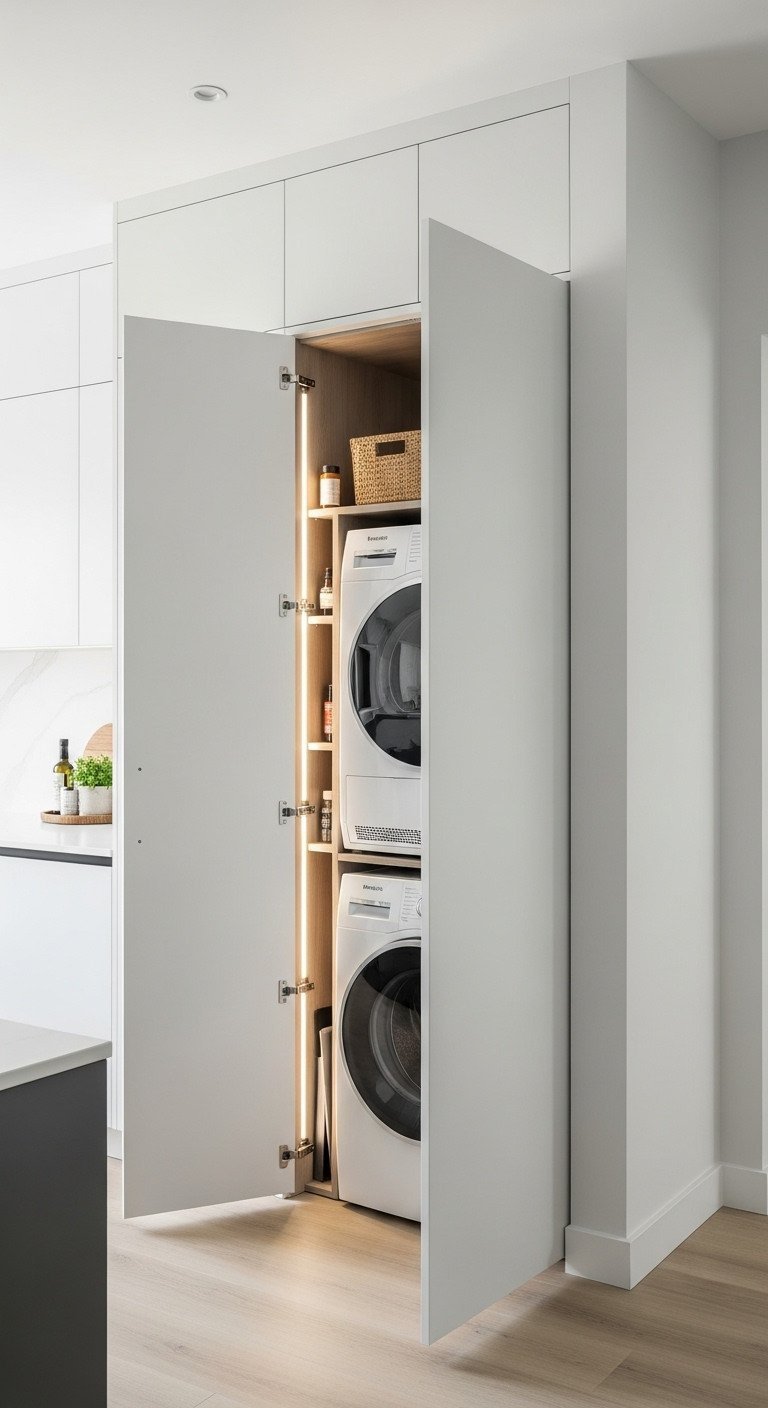
Pin this ultimate hidden laundry station for a minimalist home!
For the ultimate in minimalist design, pocket doors are unmatched. These doors slide directly into the wall, completely disappearing when open. This allows you to have your laundry station fully accessible without any doors getting in the way, and when closed, they sit perfectly flush with the wall for a seamless, invisible finish.
Materials Needed:
- A high-quality pocket door hardware kit (frame, track, rollers)
- Custom door slabs designed to be flush with your walls or cabinetry
- A stacked washer and dryer
- This requires significant framing work and is not a simple DIY.
Step-by-Step Directions:
- Plan with a Contractor: Pocket doors require a “double” wall for the door to slide into. This must be planned during a renovation or new build.
- Frame the Pocket: Your contractor will build a thick wall that includes the pocket door frame kit, creating the cavity for the door.
- Run Utilities: All plumbing, electrical, and venting must be run into the back wall of the laundry closet before drywall is installed.
- Install Track & Drywall: The pocket door track is installed within the framing. Drywall is then carefully installed over the pocket frame.
- Hang the Doors: The doors are hung on the track before the final trim work is done. They are then adjusted to slide smoothly and sit perfectly flush when closed.
- Install Appliances: Finally, the washer and dryer are installed in the finished closet.
Lesson Learned: Investing in a top-tier pocket door hardware kit is essential. A cheap, flimsy track will lead to wobbly doors that can come off the track, which are extremely difficult to repair once the wall is closed up.
Key Takeaways: Your Quick Guide to a Hidden Kitchen Laundry
Choosing the right solution depends on your space, budget, and style. Here’s a quick comparison of the top ideas to help you decide.
| Solution Type | Best For | Estimated Cost | Key Benefit |
|---|---|---|---|
| Custom Cabinetry | Seamless, high-end look | $$$$ | Completely invisible integration |
| Bifold Doors | Narrow spaces & corners | $$ | Doors don’t block walkways |
| Fabric Curtain | Renters & small budgets | $ | Affordable and non-permanent |
| Kitchen Island | Open-plan layouts | $$$$ | Clever, multi-functional use of space |
| Tall Pantry | Using vertical space | $$$ | Creates an all-in-one laundry station |
FAQs About apartment kitchen with washing machine ideas
Do you need a special cabinet for a washing machine?
Yes, you almost always need a special cabinet. Standard kitchen cabinets are typically only 24 inches deep, while most washing machines require 28-32 inches of depth for the unit, hoses, and ventilation. Therefore, you need a custom-built, reinforced cabinet that is deeper than the rest of your kitchen cabinets.
How do you stop a washing machine in a cabinet from shaking everything?
To reduce vibration, you must ensure the machine is perfectly level. Use a spirit level to check all sides. Second, install it on a reinforced floor and cabinet base. Finally, place heavy-duty anti-vibration pads under each of the appliance’s feet to absorb the shock from the spin cycle.
Do you need to vent a dryer that’s inside a kitchen cabinet?
It depends on the type of dryer. A traditional vented dryer MUST be ducted to the outside to exhaust moisture and lint. However, a ventless dryer (condenser or heat pump model) is ideal for cabinets as it doesn’t need an external vent, though it does require good air circulation, which can be provided by louvered doors or leaving clearances.
Can a renter hide a washing machine without damaging the apartment?
Absolutely. The best non-permanent solution is a fabric curtain on a tension rod. This requires no drills or screws. You can also use a freestanding decorative screen or a freestanding cabinet unit placed in front of the appliance to conceal it without altering the kitchen structure.
Final Thoughts
That awkward washing machine doesn’t have to be the focal point of your kitchen. As you’ve seen, with a bit of creativity, you can transform it into a completely invisible, seamlessly integrated, and stylish part of your home. Whether you choose a simple curtain or a fully custom cabinet, the key is to reclaim your kitchen’s beauty and make it a space you truly love.
What clever solution are you thinking of trying in your own kitchen? Share your ideas in the comments below
Last update on 2025-11-14 at 23:26 / Affiliate links / Images from Amazon Product Advertising API
